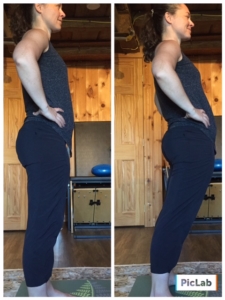Neutral Pelvis (and other joints)
When we hear the word neutral we typically think of a neutral pelvis. We don’t always consider that every one of our joints has a neutral position. That includes every vertebra in the spine through the neck, the shoulders, the knees, the elbows, the wrists, and the ankles. All joints have a neutral.
Spending time neutral reduces wear and tear on the tendons and ligaments that connect all your joints.
Neutral
 Yes people stand the way I am on the right.
Yes people stand the way I am on the right.
Luckily the body is incredibly versatile. You don’t have to exist in neutral all the time. The body is capable and, in fact, made to come out of neutral at different times for different activities and needs. That being said there is benefit to understanding when your joints are in neutral and enabling them some time to exist there. Due to tightness in our body, sometimes some of our joints rarely get to be neutral—a problem that can wreak havoc over time.
Neutral Knees
Consider your knees. If you are someone who tends to lock your knees when standing, your knees are regularly not in neutral. That locked position is going to put more pressure […]
